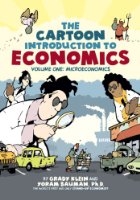Cartoon Introduction to Economics
 Cartoon introduction to economics
Cartoon introduction to economics
by Grady Klein
The award-winning illustrator Grady Klein has paired up with the world’s only stand-up economist, Yoram Bauman, PhD, to take the dismal out of the dismal science. From the optimizing individual to game theory to price theory, The Cartoon Introduction to Economics is the most digestible, explicable, and humorous 200-page introduction to microeconomics you’ll ever read.
Bauman has put the “comedy” into “economy” at comedy clubs and universities around the country and around the world (his “Principles of Economics, Translated” is a YouTube cult classic). As an educator at both the university and high school levels, he has learned how to make economics relevant to today’s world and today’s students. As Google’s chief economist, Hal Varian, wrote, “You don’t need a brand-new economics. You just need to see the really cool stuff, the material they didn’t get to when you studied economics.” The Cartoon Introduction to Economics is all about integrating the really cool stuff into an overview of the entire discipline of microeconomics, from decision trees to game trees to taxes and thinking at the margin.
Rendering the cool stuff fun is the artistry of the illustrator and lauded graphic novelist Klein. Panel by panel, page by page, he puts comics into economics. So if the vertiginous economy or a dour professor’s 600-page econ textbook has you desperate for a fun, factual guide to economics, reach for The Cartoon Introduction to Economics and let the collaborative genius of the Klein-Bauman team walk you through an entire introductory microeconomics course.



